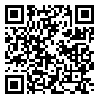Volume 8, Issue 15 (2021)
QHTS 2021, 8(15): 278-310 |
Back to browse issues page
Download citation:
BibTeX | RIS | EndNote | Medlars | ProCite | Reference Manager | RefWorks
Send citation to:



BibTeX | RIS | EndNote | Medlars | ProCite | Reference Manager | RefWorks
Send citation to:
Kokabi Dana H, saedavi A. The study of the methods of translating dual form in translations of Holy Quran and Conformity or non-conformity to the structure of Persian grammar (Elahi Qomshei, Ayyati, Khoramshahi, Ansarian). QHTS 2021; 8 (15) :278-310
URL: http://qhts.modares.ac.ir/article-10-47764-en.html
URL: http://qhts.modares.ac.ir/article-10-47764-en.html
1- Bu-Ali Sina University
2- Bu-Ali Sina University ,a.saedavi@basu.ac.ir
2- Bu-Ali Sina University ,
Abstract: (2701 Views)
Differences in grammatical structures between languages have always been one of the most challenging issues in translation. It might be said that the farther apart the two languages are in terms of origin and root, the greater the grammatical differences between them. One of the categories in which structural differences are prominent is the category of grammatical number. In Arabic, as one of the Semitic languages, there are three categorizations for number, i.e., singular, dual and plural. In Persian, which is one of the Indo-European languages, only two manifestations have been considered for the category of number, i.e., singular and plural. Now, considering that the form of the Arabic dual does not have any equivalence in the number category of Persian language, what are the solutions to translate it into Persian? After studying the translation of 150 verses containing the dual form in four translations From Elahi Qomshei, Ayati, Khoramshahi and Ansarian, the authors concluded that the translators had used four strategies in translating the dual form: 1. Using number two, 2. Affirmation and mention the dual reference, 3. Translating dual into singular and 4. excluding the dual form.
Article Type: مقالات علمی پژوهشی |
Subject:
Arts and Humanities (General)
Received: 2020/11/19 | Accepted: 2021/05/15 | Published: 2021/05/31
Received: 2020/11/19 | Accepted: 2021/05/15 | Published: 2021/05/31
Send email to the article author
| Rights and permissions | |
 |
This work is licensed under a Creative Commons Attribution-NonCommercial 4.0 International License. |







